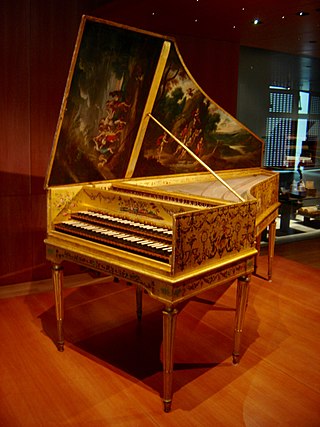
A harpsichord is a musical instrument played by means of a keyboard. This activates a row of levers that turn a trigger mechanism that plucks one or more strings with a small plectrum made from quill or plastic. The strings are under tension on a soundboard, which is mounted in a wooden case; the soundboard amplifies the vibrations from the strings so that the listeners can hear it. Like a pipe organ, a harpsichord may have more than one keyboard manual, and even a pedal board. Harpsichords may also have stop buttons which add or remove additional octaves. Some harpsichords may have a buff stop, which brings a strip of buff leather or other material in contact with the strings, muting their sound to simulate the sound of a plucked lute.

The Abbey Church of Saint Peter and Saint Paul, commonly known as Bath Abbey, is a parish church of the Church of England and former Benedictine monastery in Bath, Somerset, England. Founded in the 7th century, it was reorganised in the 10th century and rebuilt in the 12th and 16th centuries; major restoration work was carried out by Sir George Gilbert Scott in the 1860s. It is one of the largest examples of Perpendicular Gothic architecture in the West Country. The medieval abbey church served as a sometime cathedral of a bishop. After long contention between churchmen in Bath and Wells the seat of the Diocese of Bath and Wells was later consolidated at Wells Cathedral. The Benedictine community was dissolved in 1539 during the Dissolution of the Monasteries.

The pipe organ is a musical instrument that produces sound by driving pressurized air through the organ pipes selected from a keyboard. Because each pipe produces a single pitch, the pipes are provided in sets called ranks, each of which has a common timbre and volume throughout the keyboard compass. Most organs have many ranks of pipes of differing timbre, pitch, and volume that the player can employ singly or in combination through the use of controls called stops.

Aristide Cavaillé-Coll was a French organ builder. He has the reputation of being the most distinguished organ builder of the 19th century. He pioneered innovations in the art and science of organ building that permeated the profession and influenced the course of organ building, composing and improvising through the early 20th century. As the author of scientific journal articles about the organ construction details, he published the results of his research and experiments. He was the inventor of the symphonic organ being able to follow smooth and immediate dynamic changes like a symphonic orchestra. This goal was reached by: a) invention of harmonic flue and reed stops, such as the ''flûte harmonique'', ''trompette harmonique'', ''clairon harmonique'', b) invention of divided windchest with 2-3 different wind pressure sections, c) creation of groups of stops allowing for fast dynamics changes without taking hands out of the keyboards by the organist, d) organ specification planning on the base of ''orchestral quartet". His most famous organs were built in Paris in Saint-Denis Basilica (1841), Église de la Madeleine, Sainte-Clotilde Basilica (1859), Saint-Sulpice church, Notre-Dame Cathedral, baron Albert de L'Espée's residence in Biarritz, and many others. After Cavaillé-Coll's death, Charles Mutin maintained the business into the beginning of the 20th century. The organ reform movement in the 20th century sought to return organ building to a more Baroque style; but since then, Cavaillé-Coll's designs have come back into fashion.

Downside Abbey is a Benedictine monastery in England and the senior community of the English Benedictine Congregation. Until 2019, the community had close links with Downside School, for the education of children aged eleven to eighteen. Both the abbey and the school are at Stratton-on-the-Fosse, between Westfield and Shepton Mallet in Somerset, South West England. In 2020, the monastic community announced that it would move away from the present monastery and seek a new place to live. On 27 October 2021, the monastic community further announced that as part of their transition they would move in Spring of 2022 to the temporary accommodation of "Southgate House, in the grounds of Buckfast Abbey, Devon, where we will live as the Community of St Gregory the Great". As of 2020, the monastic community of Downside Abbey was home to fifteen monks.
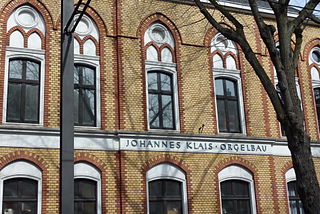
Orgelbau Klais is a German firm that designs, builds and restores pipe organs. It is a family run company, founded in 1882 by Johannes Klais senior and is now run by his great-grandson Philipp Klais. The firm is based in Bonn, Germany, and has completed many large-scale building and restoration projects around the globe in more than a century of organ building.

Metzler Orgelbau, a firm of organ builders founded in 1890 and based since 1933 in Dietikon, near Zurich in Switzerland, is one of the most important makers of the European classical organ revival and has built many important and respected instruments throughout Europe. Its instruments include:
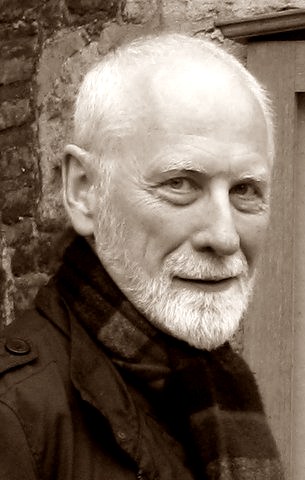
Christopher Herrick is an English concert organist best known for his interpretation of J.S. Bach’s organ music and for his many recordings on the finest pipe organs from around the world.
This article is about the numerous notable pipe organs of the city of Brighton and Hove, from the small early 19th-century organs to the large 20th-century instruments in the large churches.

Rieger Orgelbau is an Austrian firm of organ builders, known generally as Rieger. The firm was founded by Franz Rieger. From 1873 it was known as Rieger & Söhne, and from 1879 as Gebrüder Rieger, after his sons took over. At the end of World War II, the firm was nationalised by the Czech government and merged with another workshop as Rieger-Kloss. The Rieger tradition was also continued by the owners and workers of the original firm, who moved to Austria and founded a new workshop as "Rieger Orgelbau".
Lionel Rogg is a Swiss organist, composer and teacher of musical theory. He is best known for performing the music of Johann Sebastian Bach, whose complete organ works he has recorded three times.
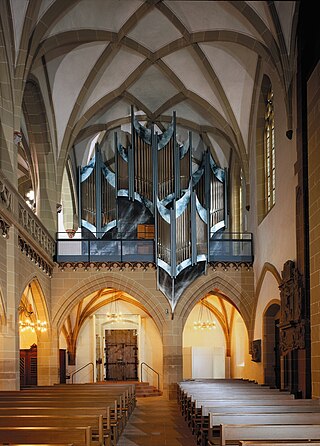
Orgelbau Vleugels is a pipe organ company producing organs in modern design and restoring historic instruments. The workshop is located in Hardheim, Germany. The owner is master pipe organ builder Hans-Georg Vleugels. The company has a history spanning over 150 years.

The Église Saint-Paul-Saint-Louis is a church on rue Saint-Antoine in the Marais quarter of Paris. The present building was constructed from 1627 to 1641 by the Jesuit architects Étienne Martellange and François Derand, on the orders of Louis XIII of France. It was the first church in Paris to break away entirely from the Gothic style and to use the new Baroque style of the Jesuits, and it had an important influence on Parisian religious architecture. It gives its name to Place Saint-Paul and its nearest Metro station, Saint-Paul. Next door to the church is the Lycée Charlemagne, also founded by the Jesuits.
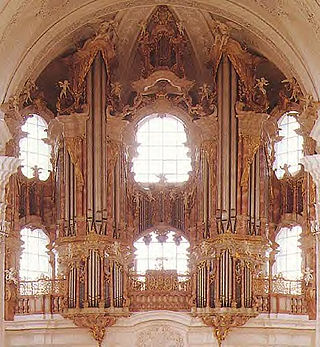
The organ at the Basilica of St. Martin (Weingarten), the monastery church of the Weingarten Abbey was built by Joseph Gabler between 1737 and 1750. In addition to the large organ he also built the small choir organ in 1743, but this has since been renovated or completely rebuilt.
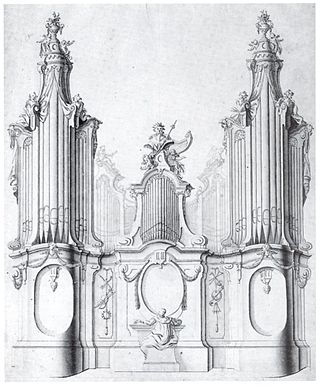
Organ building is the profession of designing, building, restoring and maintaining pipe organs.

Marienstatt Abbey is a Cistercian monastery and a pilgrimage site in Streithausen, Westerwaldkreis, Rhineland-Palatinate, in the Nister valley near Hachenburg.
Bernhardt Hilbrand Edskes was a Dutch-Swiss organist, organologist, and organ builder based in Wohlen.

The Martinskirche is the Lutheran main church in Sindelfingen, Baden-Württemberg, Germany. It was built in Romanesque style as a basilica with a flat wooden ceiling, then part of a monastery. Today, the church is also a venue of church music events.















